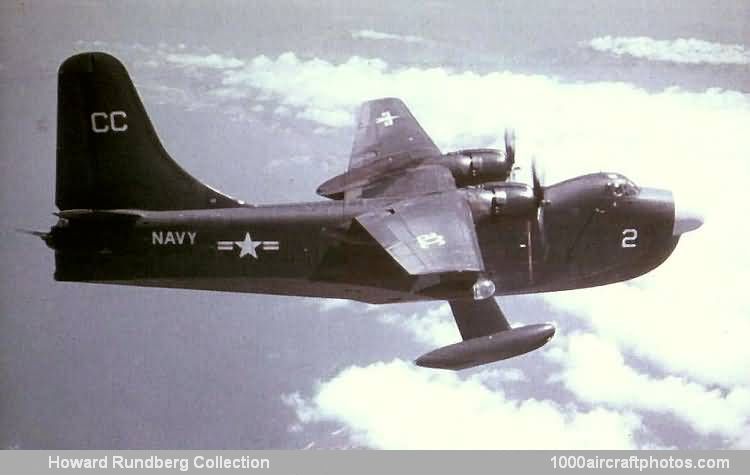08/31/2006. Remarks by Jack McKillop: "This P5M-1 was assigned to Patrol Squadron Forty Four (VP-44) based at NAS Norfolk, Virginia, USA. The squadron received its first P5M-1 on April 23, 1952 replacing Martin PBM-5s. The squadron's new 36-ton (72,000 lb, 32,659 kg) seaplane was the first in service with a Navy patrol squadron. It had a better turning circle, newer ASW and radar equipment, sturdier hull design, and more powerful engines than the PBM series.
Between July 15, and September 1954, VP-44 deployed to Pembroke Dock, Wales, UK, for 15 days of operations supported by seaplane tender USS Currituck (AV 7). The squadron departed the UK for the Mediterranean Sea in early August. After visiting numerous ports in the Mediterranean the squadron returned to NAS Norfolk, Virginia, on September 6, 1954. This deployment marked the first occasion that the P5M Marlin had been flown 'across the pond' to Europe.
In January 1955 the squadron received its first T-tail P5M-2 Marlins and received its full complement of aircraft by June 1, 1955."
12/10/2004. Remarks by Howard Rundberg: The P5M-1 was a big flying boat with R-3350 turbo-compound engines and an elaborate electrical system to supply the powerful radar. To trim it for landing the pitch trim control was set to zero and the crew moved fore or aft to obtain level-flight trim. When on the water, one wing tip pontoon would be on surface and the other up high. The beaching gear used for launch and recovery from a ramp could be mounted on one side, but to mount the other side we would have to go out the top hatch and walk out on the high-side wing until it dropped the pontoon onto the surface. Because of the beaching gear, sea anchors and rigging for launching and retrieving, the seaplane squadrons had Aviation Boatswain's Mates in the crew.
When I went into the Engineering Dept. in the 1950s one of my assignments was flight testing the dual automatic radio direction finder (ADF) installation in a P5M-1. An RA or MRA type radio range facility was required for flying the certification patterns and we used mostly the one at Gila Bend, Arizona, USA. We would come back in the afternoon and request an IFR approach whenever San Diego, California, USA was overcast. Once, when asked to report the amount of fuel remaining, our pilot replied "10 hours." Mics could be heard clicking from airplanes all around, which meant their crews were laughing because we would be put at the end of the line. We would hold in a racetrack pattern on top over the La Jolla fan marker on the north leg of the San Diego radio range and see the jets coming down on a priority approach after holding at higher altitude. The jet guys would have been hollering they were at low fuel state even before they took off. But it was OK -- we had a kitchen and a toilet.
The P5M was a stable airplane and easy to fly except the nose was round and dropped down forward which eliminated a decent reference to the horizon. It was serious enough that the pilots had to check out in the left and right seats separately. The crew groaned when I would fly it because I was making lousy, uncoordinated turns. I did better when I watched the artificial horizon for reference.
One day on the Bay preparing for take off the radioman was checking the main electrical panel and saw a popped circuit breaker. He kept pushing it in which caused the DC (direct current) ampere meter to hit full-scale. A crewman came running up to the flight deck and reported there was smoke in the fuel section. Our pilot declared an emergency and we saw the crash crew drive up to the waterfront; all they could do was look at us while we circled around out on the bay. I told the radioman to stop pushing in the circuit breaker and the smoke ceased.
The P5M has both ac (alternating current) and dc electrical systems with ac and dc generators on both engines and two 28v batteries. To keep the batteries charged in flight they are switched from No. 1 to No. 2 corresponding to odd and even hours. The battery switch had three positions, No. 1, OFF and No. 2. One time in another squadron's airplane the switch was inadvertently set to OFF. The flight controls use 28v dc and so control was lost. The problem was becoming serious when someone checked, noticed the battery switch was OFF and selected one of the batteries. A change came out shortly to replace the switch with one without an OFF position."
